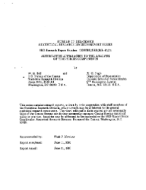Alternative Approaches to the Analysis of Time Series Components
Alternative Approaches to the Analysis of Time Series Components
Abstract
In the time series literature of recent years one finds different approaches to the analysis of time series postulated to follow some type of component structure. There are alternatives to the now familiar ARIMA (autoregressive-integrated-moving average) modeling approach, perhaps the most popular being the “structural modeling” approach of Harvey and others, which uses an explicit components structure. Despite the considerable research on these models, remarkably little work has appeared comparing results from the alternative approaches. Questions arise regarding the comparative fit of alternative models, and the effect of model choice on applications such as model-based seasonal adjustment and use of time series methods in repeated survey estimation. As these are empirical questions, we attempt to address them here through comparing results from applying such alternative models to some Census Bureau time series.
Others in Series
Working Paper
Working Paper
Working Paper




